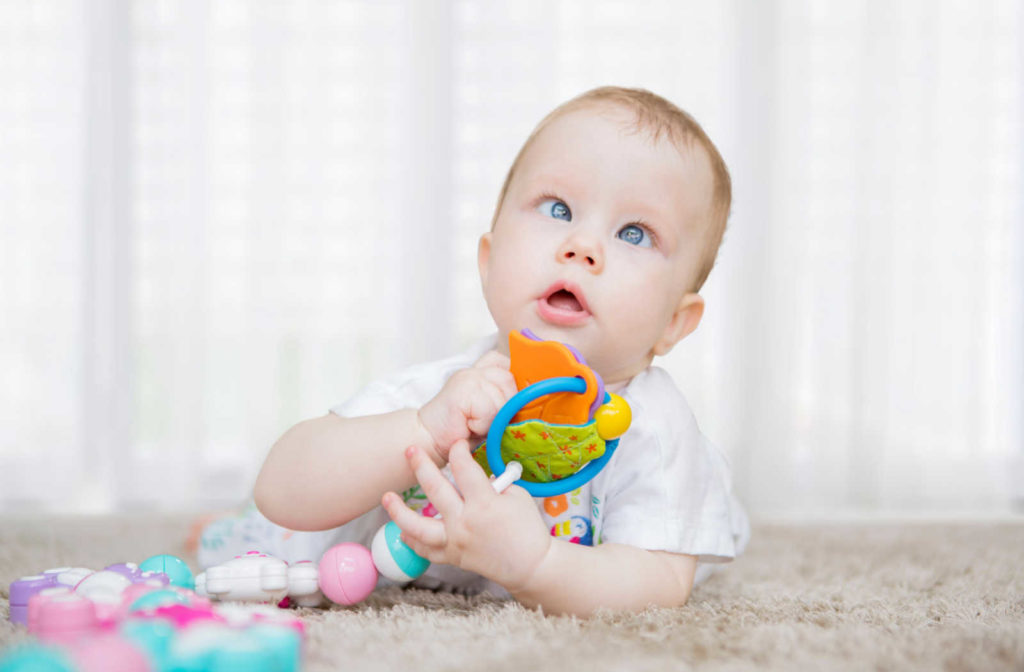Infants develop their visual skills over time, from learning better hand-eye coordination to detecting color. Every day, they’re strengthening eye muscles and improving eye teaming (both eyes working together). So, it can look a little funny to adult eyes when your child is clumsily missing an object they’re reaching for or falling for a classic game of peek-a-boo.
It can be normal for your baby’s eyes to seem cross-eyed. But a recurring eye turn can indicate an eye problem, such as an eye alignment condition or lack of visual development.
What Causes Crossed-Eyes?
There are 6 eye muscles controlling eye movement, and signals from the brain help us move these muscles. Infants learn gradually to move both eyes simultaneously to look at the same place or object. Both eyes help provide information about distance or depth, working together to create a single image.
During a child’s first 2 months, they’re still developing the eye muscles and coordination necessary to control eye movements. As a result, their eyes can seem to wander or look cross-eyed temporarily. Their eyes may also appear crossed when looking at an object that’s very close to their face. When temporary eye wandering persists, it can worsen into a more serious eye condition.
When there’s a problem with eye muscle development or movement control, the eye may turn in, out, up, or down. As a result, the eyes see 2 different images, causing confusion or double vision. Over time, the brain learns to ignore the sight from one eye to avoid confusing images. As a result, unless treated, vision may become permanently reduced in one eye.
There are 2 eye conditions associated with poor eye teaming: strabismus (crossed eyes or eye misalignment) and amblyopia (lazy eye).
Crossed Eyes vs. Lazy Eye
Crossed eyes and lazy eye are both conditions related to how the eyes work together, but they have distinct causes.
What Causes Crossed Eyes?
Crossed-eyes, or eye turn, is a condition caused by poor eye muscle control, usually developing by age 3. However, it can appear in older children and even adults. Notably, children often do not grow out of strabismus without treatment. Therefore, it’s crucial for infants to have a complete eye exam around 6 months of age to assess their eye health and visual development.
Other risk factors for developing crossed eyes include:
- Family history—children may be more likely to have crossed eyes if there’s a genetic history, such as a parent or sibling.
- Farsightedness—children with higher amounts of farsightedness (hyperopia) have to focus harder to see clearly, which can lead to eye alignment problems.
- Medical conditions—children with medical conditions (like Down Syndrome, cerebral palsy, stroke, or a head injury) may have a higher risk of developing strabismus.
Poor eye alignment can contribute to lazy eye (amblyopia).
What Causes Lazy Eye?
Parents should know that their child’s eye is not “lazy.” Instead, it’s a difference in visual acuity between eyes. The lazy eye may have a more significant refractive error, experiencing either nearsightedness (myopia) or farsightedness (hyperopia).
The vision problems caused by amblyopia, also known as lazy eye, are related to how the brain uses images received by both eyes. Like having a dominant hand, people have a dominant eye. The dominant eye isn’t always the “stronger” eye, but it is the eye the brain prefers to use.
As the brain prefers the visual information gathered by the dominant eye, it may ignore images from the non-dominant eye. Lazy eye may not be characterized by an eye turning in—the eyes may still appear straight. But, a lazy eye can show signs of an eye turn, which may be caused by strabismus.
Lazy eye usually develops before age 6 and does not affect side (peripheral) vision. However, like crossed eyes, children may not grow out of lazy eye. Vision therapy can teach the eyes to work together—and help the brain use both images.

Vision Therapy
Vision therapy is like physical therapy for the eyes. Optometrists use exercises and tools to help develop or improve visual abilities. Vision therapy looks at the entire visual system—including the eyes and brain. People of all ages can benefit from vision therapy, including children experiencing problems with eye alignment or lazy eye.
In combination with eye exercises, vision therapy methods to treat strabismus and amblyopia may include:
- Eye drops—low-dose atropine drops can dilate the eye, causing blurry vision. Applying the eye drops to the dominant eye can encourage the development of the weaker eye.
- Eyeglasses or contact lenses—corrective lenses may not reverse lazy eye or crossed eyes. Still, lenses can make visual work easier, so children see more comfortably.
- Prisms—eyeglasses with prism lenses shift images to help a misaligned eye see more comfortably and encourage both eyes to work together.
Support Your Child’s Visual Development
Supporting your child’s early visual development can benefit their lifelong vision. You can help protect your child’s eye health by scheduling their regular eye exams, and their eye doctor can watch how their vision changes as they grow.Our optometrists can assess your child’s eye care needs and create a personalized vision therapy plan. Contact Perspective Eye Center for quality eye care for the whole family.



